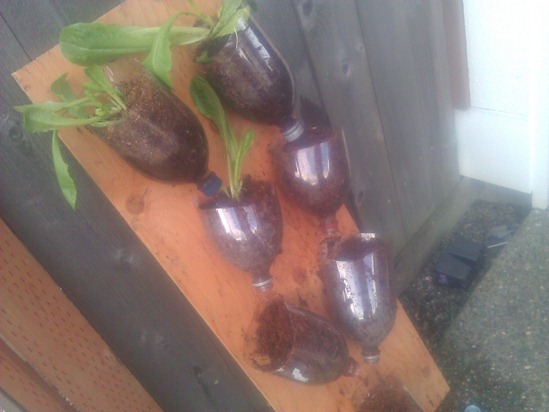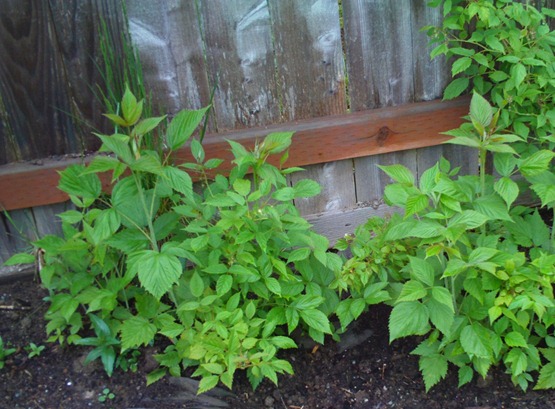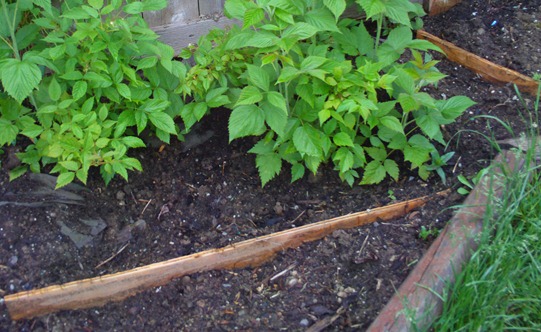vertical gardening recycling two liter bottles
12.1 years ago cheap, planter, recycle, upside down planter, vertical gardening
I am always looking for ways to enable myself to grow more in my small suburban yard. One technique to do this is using the maximum vertical space to your advantage. Whether this is growing your tomatoes and cucumbers up a trellis or growing some tomatoes from hanging upside down planters the more you successfully make use of this space the higher yields you can achieve.
One part of my yard has a great location which southern facing but do to concrete supported fence posts I can not grow anything there until now. With my homemade vertical planter I can grow a variety of small root vegetables such as lettuce, herbs, cherry tomatoes, flowers, etc.
Step #1: Cut to size. Depending on the soil needs of the plants you are growing cut off the tops using a utility knife or a good pair of scissors/kitchen shears. Cut just a bit lower on one side of the “planter” to provide a little more room for the next step and give the plant a natural way to hang over the side of the planter.
Step #2: Drill holes in top two caps. Not much else to describe here…this is done to restrict the flow of water to the planters below this one and prevent erosion of dirt out of the planters due to too high of water flow.
Step #3: Attach bottles. Pick any scrap piece of plywood you have around and attach the bottles with a couple of small screws. You can be as creative as you want on this one. A couple things to keep in mind, you want the water to flow between the planters to save yourself some time when watering these (you only have to water the top one) You also want to thing about how the plants may mature and couple block the sun from some of the plants below it, so staggering directions can help with this.
Step #4: Fill with dirt. Add some good potting soil (I went with my favorite coconut coil) and water from top to ensure water drips as expected. If you aim is off you can always add another screw (or adjust) to get everything lined up.
Below is a video of this vertical planter in action.
Controlling raspberry bushes
12.9 years ago planter, raspberries
I have considered adding raspberries in my garden but never really got around to it. This year the sort of were planted for me when my neighbors raspberry plant began sneaking under our fence. This was not exactly the location I would have chosen to plant them if I picked up a plant from the local home improvement store…but figured best to go with it than fight it since I was sure the raspberry plant would be more persistent.
The reason why I would have not chosen this location is that is right next to where I grow my tomatoes/peppers also known as the only southern facing location in my yard. I also had a hydrangea growing in the same area, though fortunately was not too established and I was able to transplant without too much shock.
To attempt to keep this creeping plant under some control I decided to setup some preventive barriers. By taking some scrap plywood leftover from my grow box expansion I created an eighteen inch deep barrier to keep the raspberries from taking over my tomato/pepper turf as well as taking over my lawn. I am pretty sure that the raspberries can still get under and/or move around it but hoping this will at least slow them down a little and save me from a little extra weeding in my lawn and garden beds.
Depending how effective (or ineffective) this is I probably will dig this out a little more and make something a little more beefy to keep these raspberries in their place…but this was as much digging as I felt comfortable doing without calling the "Call Before You Dig” folks to mark up my backyard.
Either way, I am definitely look forward to picking some fresh raspberries in my backyard this summer. Though if any of you have some great ideas how to keep your raspberry plants in check I would love to hear about them…
The Plant Whisperer
13.2 years ago electronics, planter, water

The author had a problems keeping his plants alive and provided the plants could not call out for help, he fixed this with a little bit of electronics. It will call out when it is dry and needs watering by saying phrases such as, “I’M THIRSTY! WATER ME!”
It is also detects the ambient light level and makes comments on that as well. This was put together with a little knowhow and about $30 worth of parts.
How to make your own upside Down Planter In your Garden
14 years ago garden planter, planter, upside down planter
Over the past year I have created a few different versions of garden planters for growing tomatoes, peppers, cucumbers inspired from my daughter watching a Topsy Turvy tomato planter commercial. Here is a quick summary of the different options which you can click the link for full instructions how to build on yourself.
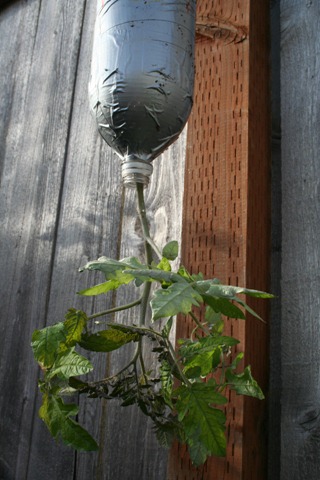 |
2 Liter – The Original — This is the one that started it all. Very simple design using a 2 liter bottle covered with duct tape with a hole cut in the side to add soil and water as needed.Pros: Simple to create, dark color helped keep soil warm during the early part of the year, unlike the sibling seedling which I planted in the ground as a control which did not make it.Cons: Really had to keep up on watering, given it had a 2 inch hole in the side water was able to easily evaporate and it did not get the advantage of being watered automatically on raining days/weeks and given I wasn’t watering any other plants forgot about this poor one which led to reduced yields. |
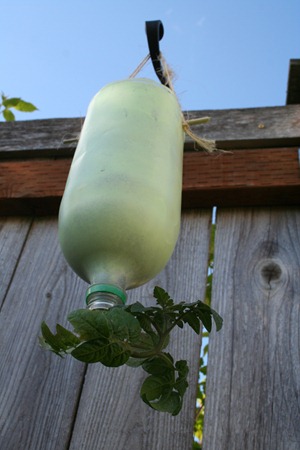 |
2 liter — Version 2.0 — This year I wanted something that did not appear as hideous hanging and also took care of the watering issue from the previous version. With this I created a slow drip watering reservoir and used spray paint and skipped the duct tape.Pros: Easy to water through manual or automatic (rain), evaporation is minimized due to small drainage holesCons: At the moment, there are none known. I am happy with this design. |
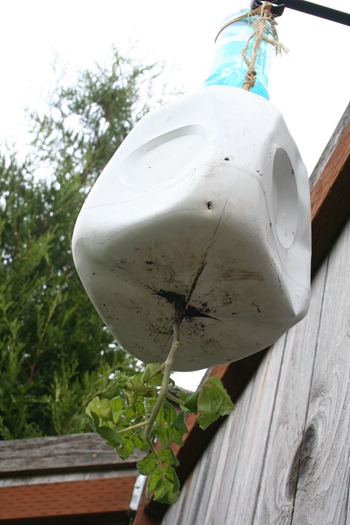 |
1 gallon milk jug (with auto-watering) — I was curious about if the extra 1.799 liters with a larger contain would significantly help yields so I went with this version. Also decided to add an experimental external watering source.Pros: Larger volume of soil, extra watering capacityCons: Keeping the whole thing balanced was a pain, currently have it under control with a couple rubber band but will probably have to be replaced with something more permanent later. |
So there you have the short evolution of my homemade upside down tomato planters all created from materials from my recycling bin. Though if you do not want to make one yourself here are a just a few of the commercial upside down planter versions on the market right now.
Tags: cheap, garden seeds, led, outdoor plants, pepper plants, tomato plants, upside down tomato planter, vegetables
